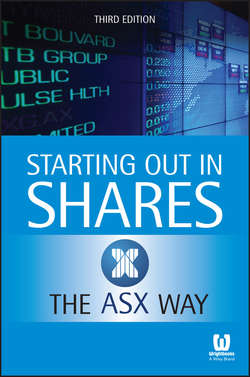Читать книгу Starting Out in Shares the ASX Way - Коллектив авторов - Страница 6
На сайте Литреса книга снята с продажи.
PART I
The basics of the sharemarket
CHAPTER 2
What is a share and what is the sharemarket?
ОглавлениеA share is simply part-ownership of a business. A company can raise money to finance its business by ‘going public’. Going public means being listed on a stock exchange and issuing shares to investors. When you buy shares in a company, you own part of that company.
The money that a company raises in the sharemarket is called ‘equity capital’. Unlike debt capital, which is borrowed money, equity capital does not need to be repaid as it represents continuous ownership of the company.
As a shareholder you have certain rights and obligations, and you also share in the risks associated with the fortunes of that company.
Shares in a listed company can be sold to other investors on the sharemarket. In this way, you can realise capital gains if the share price has risen – in other words, you can make a profit by selling the shares for more than you paid for them. As a shareholder you may benefit by receiving income in the form of cash distributions, called ‘dividends’.
As a part-owner in the business you may be entitled to vote on the direction of the company, the election of new company directors or other matters.
All shareholders should be aware that the value of a share can fall to zero. In the case of a company going broke and being wound up, shareholders rank close to last in the list of people who can claim money from the sale of the company’s assets.
What is the sharemarket?
There are a number of approved securities exchanges in Australia, the largest of which is the Australian Securities Exchange (ASX), which has more than 2000 companies on its Official List.
The sharemarket may be thought of in terms of its two separate market functions: the primary market and the secondary market.
The primary market – where it starts
If a company wants to set up a new business or expand its existing business it can raise the money (capital) it needs by issuing new shares to investors. The investors who invest money by buying these shares become shareholders in the company.
Companies that want to issue shares on the sharemarket must first be listed on an approved securities exchange. Most get listed on the ASX. The requirements for listing include being large enough to achieve a market in its shares and agreeing to abide by the ASX Listing Rules. These rules require listed companies to inform the sharemarket of any activities that may affect the price of the shares on the market and to report company profits and other specified financial information.
Many people invest in the sharemarket by participating in the initial public offering (IPO) of shares made by a company listing on the ASX. Access to public floats can vary considerably depending on the size of the float, how many shares are being made available, whether a large portion is allocated to institutional clients or retail investors, and of course whether there is a demand for shares in the company.
The terms ‘IPO’, ‘float’, ‘listing’ and ‘going public’ are often used interchangeably.
The secondary market – where people buy and sell shares
After a company has completed its float and issued shares to investors, the shares can be sold to other investors on the sharemarket. This is referred to as the secondary market.
Share trading takes place through the agency of stockbrokers who enter buy and sell orders on behalf of investors.
The price of the shares is determined by the forces of supply and demand, with investors deciding what they will pay for shares in individual companies or what they will accept for shares they already own. The growth and profitability of the companies, alongside other external factors, influence these decisions.
* * *
Now that you have an understanding of the market itself and the difference between the primary and secondary market, it is time to talk about your choices when it comes to investing.
